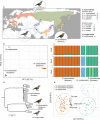Speciation and population divergence in a mutualistic seed dispersing bird
- PMID: 35534538
- PMCID: PMC9085801
- DOI: 10.1038/s42003-022-03364-2
Speciation and population divergence in a mutualistic seed dispersing bird
Abstract
Bird-mediated seed dispersal is crucial for the regeneration and viability of ecosystems, often resulting in complex mutualistic species networks. Yet, how this mutualism drives the evolution of seed dispersing birds is still poorly understood. In the present study we combine whole genome re-sequencing analyses and morphometric data to assess the evolutionary processes that shaped the diversification of the Eurasian nutcracker (Nucifraga), a seed disperser known for its mutualism with pines (Pinus). Our results show that the divergence and phylogeographic patterns of nutcrackers resemble those of other non-mutualistic passerine birds and suggest that their early diversification was shaped by similar biogeographic and climatic processes. The limited variation in foraging traits indicates that local adaptation to pines likely played a minor role. Our study shows that close mutualistic relationships between bird and plant species might not necessarily act as a primary driver of evolution and diversification in resource-specialized birds.
© 2022. The Author(s).
Conflict of interest statement
The authors declare no competing interests.
Figures




References
-
- Howe H, Smallwood J. Ecology of seed dispersal. Annu. Rev. Ecol. Syst. 1982;13:201–228. doi: 10.1146/annurev.es.13.110182.001221. - DOI
-
- Vander Wall SB, Beck MJ. A comparison of frugivory and scatter-hoarding seed-dispersal syndromes. Botanical Rev. 2012;78:10–31. doi: 10.1007/s12229-011-9093-9. - DOI
-
- Snow DW. Coevolution of birds and flowers*. Curtis’s Botanical Mag. 1994;11:198–206. doi: 10.1111/j.1467-8748.1994.tb00440.x. - DOI
-
- Grant, P. & Grant, B. 40 Years of Evolution: Darwin’s Finches on Daphne Major Island. (Princeton Univ. Press, 2014)
Publication types
MeSH terms
Associated data
LinkOut - more resources
Full Text Sources

